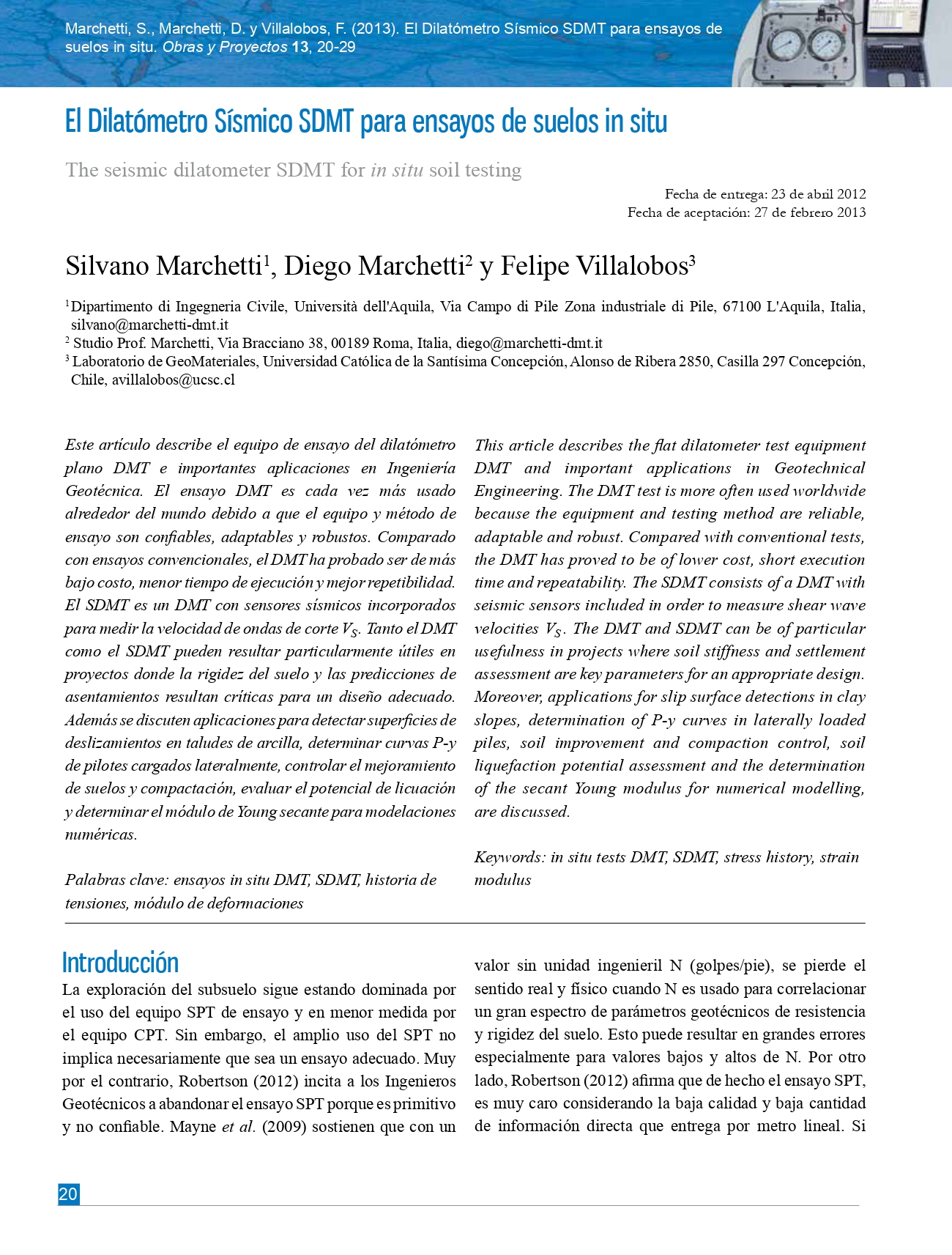The seismic dilatometer SDMT for in situ soil testing
DOI:
https://doi.org/10.4067/S0718-28132013000100002Keywords:
in situ tests DMT, SDMT, stress history, strain modulusAbstract
This article describes the flat dilatometer test equipment DMT and important applications in Geotechnical Engineering. The DMT test is more often used worldwide because the equipment and testing method are reliable, adaptable and robust. Compared with conventional tests, the DMT has proved to be of lower cost, short execution time and repeatability. The SDMT consists ofa DMT with seismic sensors included in order to measure shear wave velocities VS. The DMT and SDMT can be of particular usefulness in projects where soil stiffness and settlement assessment are key parameters for an appropriate design. Moreover, applications for slip surface detections in clay slopes, determination of P-y curves in laterally loaded piles, soil improvement and compaction control, soil liquefaction potential assessment and the determination of the secant Young modulus for numerical modelling, are discussed.
References
Amoroso, S., Monaco, P. and Marchetti, D. (2012a). Use of the Seismic Dilatometer (SDMT) to estimate in situ G-g decay curves in various soil types. Proceedings of the International Conference on Geotechnical and Geophysical Site Characterization 4, Coutinho & Mayne (eds), Taylor & Francis, Vol. 1, 489 -497.
Amoroso, S., Lehane, B.M. and Fahey, M. (2012b). Determining G-g decay curves in sand from a Seismic Dilatometer Test (SDMT). Proceedings of the International Conference on Geotechnical and Geophysical Site Characterization 4, Coutinho & Mayne (eds), Taylor & Francis, Vol. 1, 447 -452.
Andrus, R.D. and Stokoe II, K.H. (2000). Liquefaction resistance of soils from shear-wave velocity. Journal of Geotechnical and Geoenvironmental Engineering 126, No.11, 1015-1025. https://doi.org/10.1061/(ASCE)1090-0241(2000)126:11(1015)
ASTM D6635 (2001, 2007). Standard Test Method for Performing the Flat Plate Dilatometer. Book of Standards, West Conshohocken, PA, USA.
Baldi, G., Bellotti, R., Ghionna, V, Jamiolkowski, M. and Pasqualini, E. (1985). Penetration resistance and liquefaction of sands. Proceedings ofthe 11th ICSMFE, San Francisco, vol. 4, 1891-1896.
Baligh, M.M. and Scott, R.F. (1975). Quasi Static Deep Penetration in Clays. Journal of the Geotechnical Engineering Division 101, No. 11, 1119-1133.
BSSC Building Seismic Safety Council (2004). NEHRP Recommended provisions for seismic regulations for new buildings and other structures. FEMA 450/451, 19-38.
Eurocode 7 (1997, 2007). Geotechnical Design - Part 2: Ground Investigation and Testing. EN 1997-2:2007.
Eurocode 8 (2004). Design of structures for earthquake resistance. Part 1: general rules, seismic actions and rules for buildings. EN 1998-1: 2004.
Hamza, M. and Richards, D.P. (1995). Correlations of DMT, CPT and SPT in Nile Basin Sediment. Proceedings 11th African Conference SMFE, Cairo Egypt, 437-446.
Hepton, P. (1988). Shear wave velocity measurements during penetration testing. Proceedings of Penetration Testing in the UK, ICE, 275-278.
Lee, M.J., Choi, S.K., Kim, M.T. and Lee, W. (2011). Effect of stress history on CPT and DMT results in sand. Engineering Geology 117 (3-4), 259-265.
Marchetti, S. (2010). Sensitivity of CPT and DMT to stress history and aging in sands for liquefaction assessment. Proceedings CPT 2010 International Symposium Huntington Beach, California.
Marchetti, S., Monaco, P., Totani, G. and Marchetti, D. (2008). In situ tests by seismic dilatometer (SDMT). Proceedings From Research to Practice in Geotechnical Engineering, ASCE Geotech. Spec. Publ. No. 180 (honoring J.H. Schmertmann), 292-311. https://doi.org/10.1061/40962(325)7
Marchetti, S. (1994). An example of use of DMT as an help for evaluating compaction of subgrade and underlying embankment. Internal Technical Note.
Marchetti, S., Totani, G., Calabrese, M. and Monaco, P. (1991). P-y curves from DMT data for piles driven in clay. Proceedings of the 4th International Conference on Piling and Deep Foundations, DFI, Stresa, Vol. 1, 263-272.
Marchetti, S. (1982). Detection of liquefiable sand layers by means of quasi-static penetration tests. Proceedings 2nd European Symposium on Penetration Testing, Amsterdam, vol. 2, 689-695.
Marchetti, S. (1980). In Situ Tests by Flat Dilatometer. Journal ofthe Geotechnical Engineering Division 106, No. 3, 299-321. https://doi.org/10.1061/AJGEB6.0000934
Marchetti, S. (1975). A New in Situ Test for the Measurement of Horizontal Soil Deformability. Proceedings of the Conference on In Situ Measurement of Soil Properties, ASCE Spec. Conf., Raleigh, Vol. 2, 255-259.
Mayne, P.W., Coop, M.R., Springman, S.M., Huang, A.B. and Zornberg, J.G. (2009). Geomaterial behaviour and testing. State of the art Paper. Proceedings of the 17th ICSMGE, Alexandria, Egypt, Vol. 4: 2777-2872.
Monaco, P., Marchetti, S., Totani, G. and Marchetti, D. (2009). Interrelationship between small strain modulus G0 and operative modulus. Proceedings of the International Conference on Performance-Based Design in Earthquake Geotechnical Engineering, Kokusho, Tsukamoto and Yoshimine (eds.), Tsukuba, Taylor & Francis, 1315-1323.
Monaco, P. and Marchetti, S. (2007). Evaluating liquefaction potential by seismic dilatometer (SDMT) accounting for aging/ stress history. Proceedings of the 4th International Conference on Earthquake Geotechnical Engineering ICEGE4, Thessaloniki, paper 1626.
Monaco, P., Marchetti, S., Totani, G. and Calabrese, M. (2005). Sand liquefiability assessment by Flat Dilatometer Test (DMT). Proceedings XVI ICSMGE, Osaka, vol. 4: 2693-2697.
Monaco, P. and Marchetti, S. (2004). Evaluation of the coefficient of subgrade reaction for design of multi-propped diaphragm walls from DMT moduli. Proceedings International Site Characterization ISC'2, Porto, Portugal.
NCh 433 DS 61 (2011). Diseño sísmico de edificios. Decreto 61. Reglamento que fija el diseño sísmico de edificios. Santiago, Chile.
Reyna, F. and Chameau, J.L. (1991). Dilatometer based liquefaction potential of sites in the Imperial Valley. Proceedings 2nd International Conference on Recent Advances in Geotechnical Earthquake Engineering and Soil Dynamics, St. Louis, 385-392.
Robertson, P.K. (2012). Interpretation of in-situ tests - some insights. The James K. Mitchell lecture. Proceedings of the International Conference on Geotechnical and Geophysical Site Characterization 4, Porto de Galinhas, Brasil, Coutinho & Mayne (eds.), Taylor & Francis, Vol. 1, 3 -24.
Robertson, P.K. and Campanella, R.G. (1986). Estimating liquefaction potential of sands using the Flat Plate Dilatometer. Geotechnical Testing Journal 9(1), 38-40. https://doi.org/10.1520/GTJ10610J
Robertson, P.K., Davies, M.P. and Campanella, R.G. (1987). Design of laterally loaded driven piles using the flat dilatometer. Geotechnical Testing Journal 12, No. 1, 30-38. https://doi.org/10.1520/GTJ10671J
Schanz, T. and Vermeer, P.A. (1997). On the Stiffness of Sands. Proceedings Symposium on Pre-failure Deformation Behaviour of Geomaterials, ICE, London, 383-387.
Schmertmann, J.H., Baker, W., Gupta, R. and Kessler, K. (1986). CPT/DMT Quality control of ground modification at a power plant. Proceedings of In Situ '86, Conference on Use of In Situ Tests in Geotechnical Engineering, Virginia Tech, Blacksburg, ASCE Geot. Special Publ. No. 6, 985-1001.
Schnaid, F. (2009). In Situ Testing in Geomechanics - the main tests. Taylor & Francis Group, London.
TC16 (2001). The Flat Dilatometer Test (DMT) in Soil Investigations. A Report by the ISSMGE Committee TC16. Reprinted in Proceedings of the 2nd International Conference on the Flat Dilatometer, 2006, Washington D.C., 7-48.
Totani, G., Calabrese, M., Marchetti, S. and Monaco, P. (1997). Use of in situ flat dilatometer (DMT) for ground characterization in the stability analysis of slopes. Proceedings XIV ICSMFE, Hamburg, vol. 1, 607-610.
Totani, G., Calabrese, M. and Monaco, P. (1998). In situ determination of Ch by Flat Dilatometer (DMT). Proceedings of the First International Conference on Site Characterization ISC '98, Atlanta, Georgia, USA, 883-888.
Totani, G., Monaco, P., Marchetti, S. and Marchetti, D. (2009). Vs measurements by Seismic Dilatometer (SDMT) in non penetrable soils. Proceedings 17th ICSMGE, Alexandria, Egypt, 2, 977-980. https://doi.org/10.3233/978-1-60750-031-5-977
Yu, H.S. (2004). In situ soil testing: from mechanics to interpretation. Proceedings 2nd International Conference on Site Characterization, ISC-2, Porto. vol. 1, 3-38.

Downloads
Published
Issue
Section
License
Copyright (c) 2013 Universidad Católica de la Santísima Concepción

This work is licensed under a Creative Commons Attribution-NonCommercial 4.0 International License.







